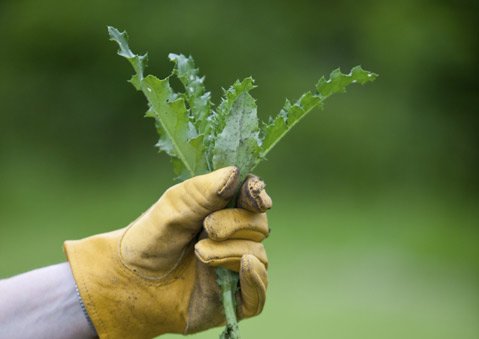Garden Invaders
Pesky, Fast-Growing Summer Weeds

I just got back from a wonderful vacation. It was great to be home, sleep in my own bed, find a snack as handy as my own kitchen, and wear different clothes (anything but those few well-planned outfits that fit in just one suitcase but can take you from the bush to the theater!). It was also dismaying to see the state of my garden. My good friend had kept everything well watered, so still living, but many things had been overshadowed by quick growing weeds, some of them already going to seed. As I got to work, it occurred to me that this was a special subset of weeds. These weeds were the ones that show up in the summer. No less pesky, but it was interesting to think about their particular characteristics.
First up was a creeping devil of a plant. A species of oxalis, it has cute little “three-leaf clover” leaves and tiny yellow flowers. Its nasty habit, though, is that it can root wherever its stems touch the ground. Although it is easy to pull out, roots and all, just when you think you’ve gathered up all the stray bits, one more rooted stem appears, lurking right there in the center of the shallots. To compound the insult, it makes loads of seed capsules that explode at the slightest touch, scattering seeds far and wide.
Another summer weed is even lower to the ground. This one, called spurge, is a member of the euphorbia family. The same syndrome of wide-spreading stems that root at will and loads of nearly microscopic seeds ensure that it will always be around. That’s no reason to leave any in the garden, of course, but it does make this chore one of the more discouraging ones.
One weed that I didn’t see, but more or less expected, was purslane (maybe next week, eh?). This succulent plant, which is in the same family as several ornamentals such as portulaca, is also easily pulled. In fact, it can join the harvest for the dinner salad or be added to the stir fry.
A few of our “weeds” are just misplaced natives. I haven’t positively identified which everlasting (in the genus Gnaphalium) it is that continues to pop up not only in the prepared beds but also in the gravel walkways, but its seeds probably wafted down from the chaparral up on the hills. It has silvery fuzz and smells faintly of maple syrup when bruised. Its relatives (all are in the sunflower family) dandelion and prickly lettuce germinate most of the year, so it is not unusual to find them, either.
Another local, the coast live oak, had a banner acorn year, and its seeds are sprouting, too. They may be near or under their parent trees but could also appear wherever the jays or squirrels hid them. At this stage, they are pretty easy to eradicate, even though they may have quite a deep taproot. Once they really dig in, it takes a shovel to get rid of them. I’ve been hacking at one for several years now that is just too close to a fence line. If I’d discovered it in its first season, it would have been a snap to remove.
One of the most persistent weedy species is a long-stemmed grass. It germinates almost anywhere, grows into a lanky bunch of stems, and spreads its seeds quickly. To complicate its removal, the stems are prone to break easily right at the crown, leaving the roots to regenerate a new crop. While pulling one of those, I found another patch of misplaced seedlings growing among the cymbidium leaves. The orchids enjoy a nice half-shaded spot near a pittosporum hedge. The pittosporum drops its seeds wherever it can, and if a moist site such as a cymbidium pot happens to be there, it is a match made in weed heaven. Luckily, the porous bark medium that cymbidiums love makes pulling any weeds a breeze.
All gardeners know that weeding is just one of those inevitable and recurring tasks. There are some ways to cut down on the number of weeds, though. The worst spot in my neglected garden was the area I hadn’t gotten around to mulching again after pulling out the cabbage plants. Maintaining an unbroken layer of mulch can make a huge difference in the ability of unwanted seeds to germinate and get established. Don’t water bare areas; the use of drip and “leaky hose” kinds of irrigation systems that direct water just to the desirable garden plants can also help. And, lastly, go on vacation, but when you are at home, get those weeds when they are small.



